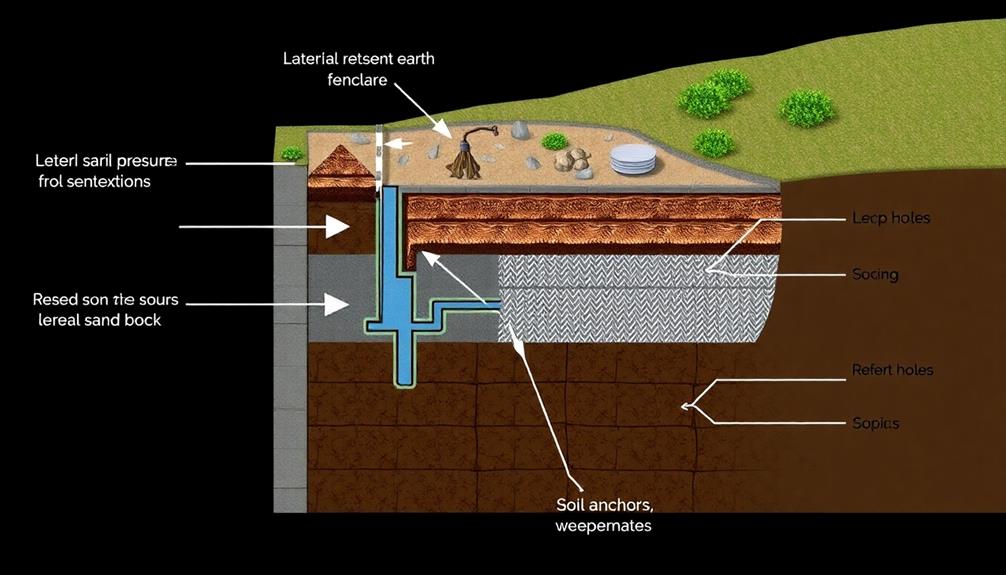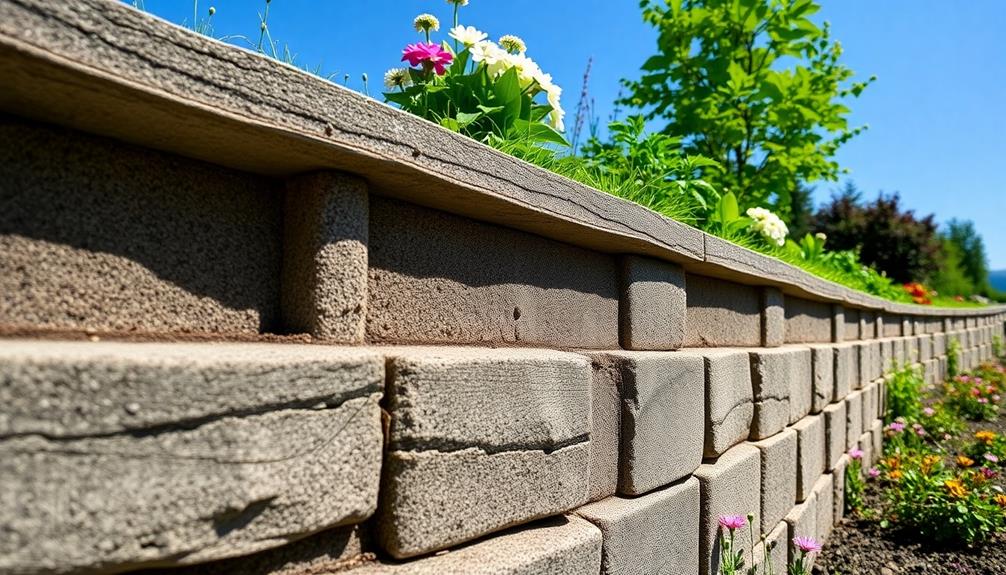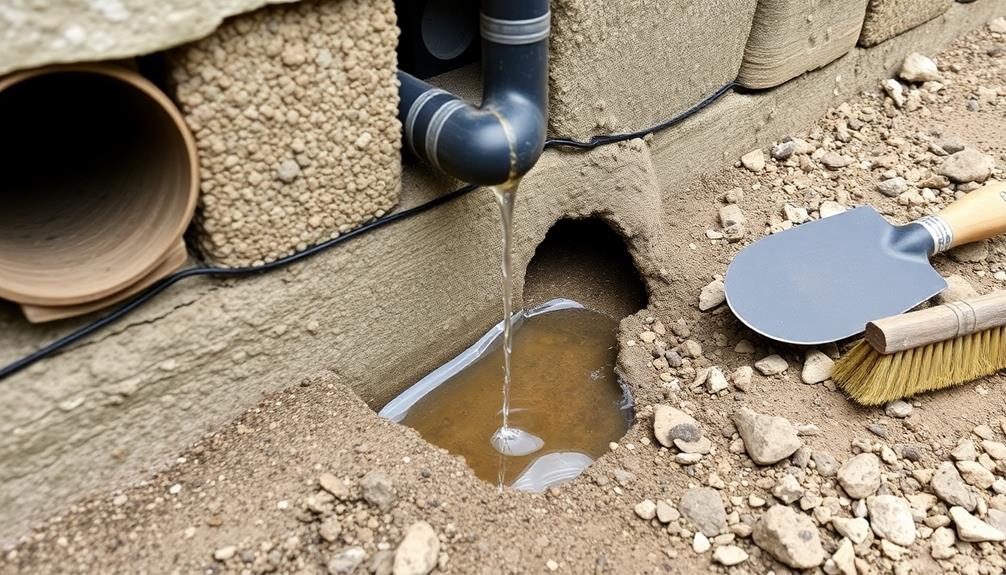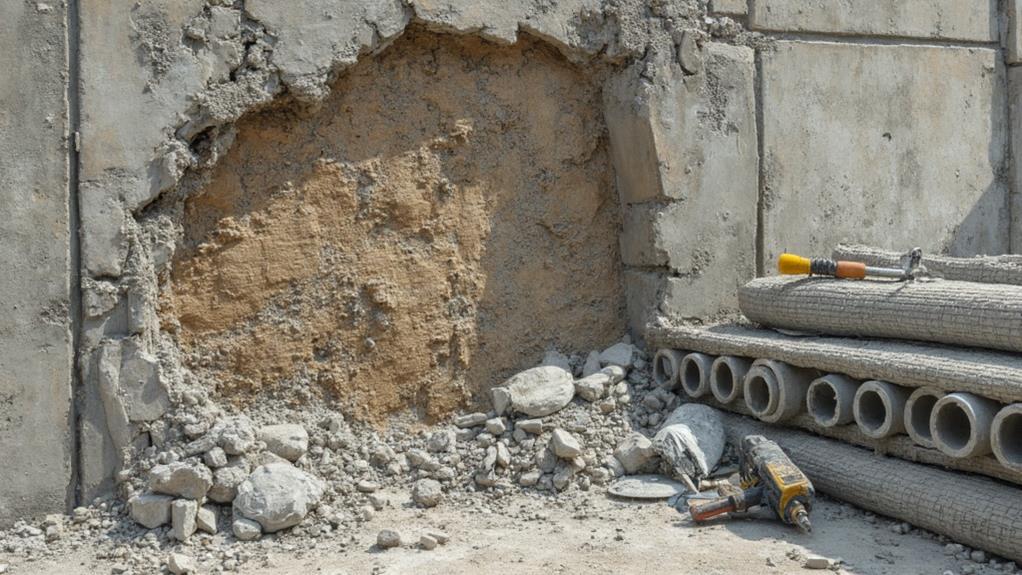Implementing effective repair techniques for retaining walls requires a multi-faceted approach addressing lateral earth pressure management, drainage system improvements, and structural reinforcement. Key strategies include installing extensive drainage networks with perforated pipes, geotextile fabrics, and weep holes to manage water flow. Reinforcement techniques such as soil anchors, geogrids, and helical tie-backs enhance wall stability. Proper soil compaction using appropriate methods for different soil types is indispensable. Regular maintenance of drainage systems, including clearing clogs and repairing damaged components, is essential for long-term wall integrity. These measures not only prevent costly repairs but also extend the lifespan of retaining walls, protecting property values and ensuring structural soundness. Further exploration of these techniques reveals additional benefits and implementation details.
Table of Contents
ToggleWalls Contractor Highlights
- Improve drainage by installing perforated pipes, gravel envelopes, and geotextile fabrics to reduce water pressure behind the wall.
- Reinforce the wall using soil anchors, geogrids, or helical tie-backs to distribute load and prevent movement.
- Address soil compaction issues using appropriate methods like vibratory plate compactors or sheepsfoot rollers.
- Repair damaged sections promptly, including fixing cracks, replacing deteriorated materials, and resealing joints.
- Implement regular maintenance routines, including clearing drainage systems and conducting structural inspections to prevent future issues.
Lateral Earth Pressure Management

Effective management of lateral earth pressure is indispensable for the longevity and stability of retaining walls, necessitating a multifaceted approach to repair and reinforcement. It is important to guarantee compliance with relevant local building codes and standards during any repair or construction process.
Key strategies in this endeavor include enhancing drainage systems to mitigate hydrostatic pressure, implementing advanced reinforcement installation techniques to bolster structural integrity, and employing precise soil compaction methods to optimize load distribution. For retaining walls made of specialized materials like boulder retaining walls, expertise in installation and repair is essential due to their size and the natural appearance they provide.
These interrelated techniques work synergistically to counteract the detrimental effects of lateral earth pressure, thereby extending the functional lifespan of retaining walls and ensuring their continued efficacy in soil retention and erosion control.
Drainage System Improvements
Water, the silent enemy of retaining walls, can exert tremendous lateral earth pressure when not properly managed. To mitigate this threat, implementing effective drainage system improvements is indispensable for maintaining the integrity and longevity of retaining structures. A well-designed drainage system alleviates hydrostatic pressure, reduces soil saturation, and prevents erosion, ultimately safeguarding the wall against potential failure.
To enhance drainage capabilities, consider installing an extensive network of perforated pipes behind the wall, strategically positioned to collect and redirect water away from the structure. These pipes should be encased in a permeable gravel envelope to facilitate efficient water movement. Additionally, incorporating geotextile fabric between the backfill and drainage materials prevents soil particles from clogging the system over time.
For peak performance, integrate weep holes or drain tiles at regular intervals along the wall's face, allowing trapped water to escape. Implementing a surface drainage system, such as swales or French drains, further complements these efforts by diverting surface runoff before it reaches the retaining wall. By addressing drainage concerns proactively, property owners can greatly extend the lifespan of their retaining walls and minimize the risk of costly repairs or failures.
Reinforcement Installation Techniques
While proper drainage is essential, managing lateral earth pressure through reinforcement installation techniques is equally important for retaining wall stability. These techniques involve integrating additional support structures to counteract the forces exerted by the soil behind the wall.
One effective method is the installation of soil anchors, which are long steel rods or cables driven deep into the earth and secured to the wall's face. These anchors distribute the load across a larger area, drastically reducing the risk of wall failure.
Another indispensable reinforcement technique is the use of geosynthetic materials, such as geogrids or geotextiles. These materials are layered within the backfill soil during construction or repair, creating a composite mass that enhances the wall's structural integrity. The geosynthetics interlock with the soil particles, increasing friction and lowering lateral pressure on the wall.
Additionally, helical tie-backs can be employed to provide extra support, particularly in cases where the wall shows signs of bowing or leaning. These screw-like devices are driven into the soil behind the wall and connected to its face, effectively anchoring it in place and preventing further movement. Implementing these reinforcement techniques guarantees the long-term stability and functionality of retaining walls.
Soil Compaction Methods
Beyond reinforcement techniques, proper soil compaction methods play a pivotal role in managing lateral earth pressure for retaining walls. Effective soil compaction ensures stability and longevity of the repaired structure by reducing settlement and increasing soil strength. The process involves systematically densifying the backfill material to achieve ideal soil particle arrangement, minimizing voids and enhancing load-bearing capacity.
Several compaction methods are available, each suited to specific soil types and site conditions. Vibratory plate compactors are ideal for granular soils, providing excellent particle rearrangement through high-frequency vibrations. For cohesive soils, sheepsfoot rollers or pneumatic tire rollers are more effective, kneading the soil to reduce air voids. In confined spaces or around drainage structures, hand-operated tampers or rammers may be necessary to ensure thorough compaction.
To achieve ideal results, it is imperative to compact soil in thin lifts, typically 6-8 inches thick, and maintain proper moisture content. This approach allows for uniform density throughout the backfill, preventing differential settlement and ensuring consistent lateral earth pressure distribution. Regular field density tests, such as nuclear density gauge measurements or sand cone tests, should be conducted to verify that specified compaction levels are achieved, typically 95% of maximum dry density as determined by standard Proctor tests.
Benefits

Implementing effective retaining wall repair techniques offers numerous advantages that extend beyond mere structural improvement. These benefits encompass significant cost savings over time, substantial enhancement of the wall's structural integrity, noticeable improvement in overall property aesthetics, and a considerable extension of the wall's lifespan.
Cost Savings Over Time
The long-term cost savings associated with proper retaining wall repair techniques can be substantial. By investing in timely and effective repairs, property owners can avoid the exponential increase in expenses that often accompanies neglected structural issues. Implementing these techniques not only preserves the integrity of the retaining wall but also protects surrounding landscaping and infrastructure from potential damage caused by wall failure.
Over time, the cumulative benefits of regular maintenance and proactive repairs become increasingly apparent. The prevention of soil erosion, water damage, and structural deterioration translates into significant financial advantages for homeowners and businesses alike. By addressing minor issues before they escalate into major problems, individuals can circumvent the need for costly complete wall replacements or extensive renovations.
In addition, well-maintained retaining walls contribute to improved property values, potentially yielding higher returns on investment when selling or refinancing. The adoption of proper repair techniques also reduces the likelihood of liability issues stemming from wall failures, thereby mitigating potential legal expenses and insurance premiums. Ultimately, the judicious application of retaining wall repair methods proves to be a financially prudent decision that pays dividends in both the short and long term.
Enhanced Structural Integrity
While cost savings are a significant benefit, the enhanced structural integrity achieved through proper retaining wall repair techniques offers numerous advantages. By implementing effective repair methods, property owners can guarantee their retaining walls maintain ideal performance and longevity. These techniques not only address existing issues but also fortify the structure against future challenges, creating a more robust and reliable barrier.
Improved structural integrity translates to increased safety for both residents and surrounding structures. Properly repaired retaining walls are better equipped to withstand soil pressure, water infiltration, and environmental stressors, reducing the risk of catastrophic failure. This enhanced stability also contributes to improved aesthetics, as a well-maintained wall presents a more appealing appearance and can increase property value.
Furthermore, strengthened retaining walls offer superior protection against erosion and soil movement, safeguarding the landscape and preventing potential damage to nearby buildings or infrastructure. By investing in thorough repair techniques, property owners demonstrate a commitment to maintaining the integrity of their land and surrounding community. This proactive approach not only preserves the functionality of the retaining wall but also fosters a sense of security and belonging among residents who rely on these structures for protection and stability.
Improved Property Aesthetics
Beyond structural benefits, retaining wall repair techniques markedly enhance property aesthetics. A well-maintained retaining wall not only safeguards your landscape but also serves as a striking visual element that can substantially elevate your property's curb appeal. By implementing effective repair methods, homeowners can transform weathered, crumbling walls into pristine architectural features that complement their outdoor spaces.
These aesthetic improvements often involve addressing surface imperfections, such as cracks, stains, or efflorescence, through meticulous cleaning and resurfacing processes. Skilled technicians can apply specialized coatings or veneers to rejuvenate the wall's appearance, mimicking natural stone or creating a sleek, modern finish.
Additionally, integrating decorative elements like cap stones, built-in lighting, or cascading plants can further enhance the wall's visual appeal. Such enhancements not only beautify the immediate area but also contribute to a cohesive landscape design that resonates with the property's overall aesthetic. Consequently, a visually appealing retaining wall can potentially increase property value, making it an investment that yields both practical and financial benefits for homeowners seeking to cultivate a distinguished and well-maintained outdoor environment.
Extended Wall Lifespan
Extending the lifespan of retaining walls stands as a paramount benefit of implementing proper repair techniques. By addressing issues promptly and effectively, property owners can significantly prolong the functionality and structural integrity of their retaining walls. This proactive approach not only safeguards the investment but also guarantees the continued protection of the surrounding landscape and infrastructure.
When retaining walls are properly maintained and repaired, they become more resilient to environmental stressors such as soil pressure, water infiltration, and freeze-thaw cycles. The reinforcement of weakened areas, replacement of damaged components, and application of protective coatings all contribute to the wall's longevity. Furthermore, regular inspections and timely interventions prevent minor issues from escalating into major structural failures, which could necessitate costly complete replacements.
Drainage System Maintenance Procedures

Maintaining the drainage system of a retaining wall is essential for its longevity and structural integrity. Proper maintenance procedures include clearing clogged drainage pipes, repairing damaged weep holes, and ensuring appropriate grading around the wall. The following table outlines key aspects of these maintenance tasks:
| Procedure | Frequency | Tools Required | Professional Assistance |
|---|---|---|---|
| Clear Drainage Pipes | Bi-annually | Pressure washer, Plumbing snake | Recommended for severe clogs |
| Repair Weep Holes | As needed | Masonry drill, Epoxy | Required for extensive damage |
| Maintain Grading | Annually | Shovel, Rake, Level | Advised for large-scale regrading |
Clear Clogged Drainage Pipes
Unclogging drainage pipes is a vital step in maintaining the effectiveness of a retaining wall's drainage system. As members of a community dedicated to preserving our infrastructure, it's necessary that we understand and implement proper techniques to clear obstructions in these essential conduits. The process begins with a thorough inspection of the drainage pipes using specialized cameras or scopes to identify the location and nature of the blockage.
Once the obstruction is located, several methods can be employed to clear it. Hydro-jetting, a high-pressure water cleaning technique, is often the most effective for removing sediment, roots, and debris. For more stubborn blockages, mechanical augers or snakes may be necessary to break through the clog.
In severe cases, excavation and pipe replacement might be required. It's crucial to approach this task methodically, documenting each step and noting any structural issues encountered during the process. Regular maintenance schedules should be established to prevent future blockages, including periodic flushing of the pipes and installation of protective grates at pipe openings to minimize debris intrusion.
Repair Damaged Weep Holes
Weep holes play a crucial role in the drainage system of retaining walls, and their proper functioning is indispensable for the wall's longevity and stability. When these critical components become damaged or obstructed, immediate action is necessary to prevent water buildup and potential structural issues.
To repair damaged weep holes, begin by thoroughly inspecting the affected areas, identifying any cracks, blockages, or deterioration. For minor damage, clean the weep holes using a high-pressure water jet or a specialized drain snake to remove debris and mineral deposits. In cases of more severe damage, it may be necessary to carefully enlarge the openings using a masonry drill bit, guaranteeing not to compromise the wall's integrity.
Once cleared or enlarged, install new weep hole devices, such as plastic tubing or preformed inserts, to maintain proper drainage channels. To prevent future damage, consider implementing protective measures like installing mesh screens or gravel filters around the weep holes. These additions help filter out debris while allowing water to flow freely.
Regular maintenance, including periodic cleaning and inspection, will guarantee the continued effectiveness of your retaining wall's drainage system, safeguarding your property against potential water-related damage.
Maintain Proper Grading
While repairing weep holes is essential for retaining wall health, proper grading around the structure is equally important for effective drainage. Maintaining the correct slope away from the wall guarantees that water flows away from the foundation, preventing hydrostatic pressure buildup and potential structural damage.
To achieve prime grading, follow these steps:
- Assess the current grade: Use a level or transit to measure the existing slope, identifying areas where water may pool or flow towards the wall.
- Remove excess soil: Carefully excavate any accumulated soil near the wall, ensuring a minimum of 6 inches of the wall's base remains exposed.
- Add compacted fill: Gradually build up the soil grade, sloping away from the wall at a rate of 1 inch per foot for at least 6 feet.
Regular maintenance of the grading system is indispensable for long-term retaining wall stability. Conduct periodic inspections, especially after heavy rainfall or snowmelt, to identify and address any erosion or soil settlement issues promptly. By implementing these drainage system maintenance procedures, property owners can vastly extend the lifespan of their retaining walls and protect their investments.
Walls Contractor FAQ
How Often Should Retaining Walls Be Inspected for Potential Damage?
Regular inspections are essential for maintaining retaining walls. As a community, we should aim to inspect our walls at least annually, with additional checks after severe weather events or nearby construction. This proactive approach guarantees our safety and property integrity.
What Are Signs That a Retaining Wall Needs Immediate Repair?
Fellow property owners, be vigilant for these critical signs: visible cracks, bulging or leaning, water seepage, soil erosion behind the wall, or separation from adjacent structures. These indicators suggest your retaining wall requires immediate professional attention to guarantee safety and stability.
Can DIY Repairs Be Done on Retaining Walls?
While DIY repairs can be tempting, retaining walls are complex structures that often require professional expertise. For the safety of our community and property, it's best to consult with a qualified contractor for any necessary repairs or maintenance.
What Materials Are Best for Repairing Cracks in Concrete Retaining Walls?
For repairing cracks in concrete retaining walls, we recommend using high-quality epoxy or polyurethane injection, hydraulic cement, or specialized concrete patching compounds. These materials provide excellent adhesion, durability, and water resistance, ensuring long-lasting repairs for our community's structures.
How Long Does a Typical Retaining Wall Repair Process Take?
The duration of a retaining wall repair process varies depending on the extent of damage and chosen repair method. Typically, minor repairs can be completed within a few days, while extensive repairs may take several weeks to finish.







